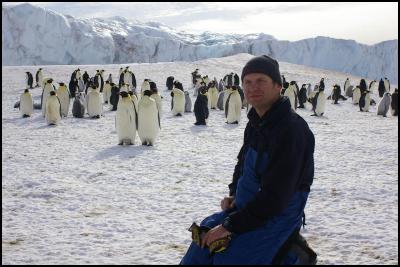Bottom-up research to understand Antarctic predator diets
media release
FOR IMMEDIATE
USE
Bottom-up research to understand Antarctic predator diets

Click for big version.
Cawthron Institute Senior Scientist Jonathan Banks at work in Antarctica.
A Nelson scientist specialising in faecal
DNA, is applying his unique expertise to an international
research project into the impacts of climate change and
commercial fishing on Anarctica’s top predators.
Cawthron
Institute Senior Scientist Jonathan
Banks has spent the past three weeks researching how
the pressures of climate change and commercial fishing are
affecting the diets of three key predators in the Ross Sea,
as part of an NZARI (New Zealand Antarctic Research
Institute) funded project. He returned to Nelson on
Monday(6 January).
“As fishing pressure is increasing we need to understand what these species are eating and how fishing activity will affect the top predators in Antarctica,” Dr Banks says.
He is one of nine researchers working on the year-long project, studying the diets of killer whales, Weddell seals and Adélie penguins to help in understanding critical food resources needed for their survival. The team’s research will also provide reference points for detecting future changes, and allow for responsible management of the Ross Sea.
While in Antarctica the team visited seal and penguin colonies spread over a 40km area, to collect faecal matter from which Dr Banks extracted DNA to bring back to Cawthron Institute laboratories for analysis. They also ice fished for fish samples that Dr Banks could compare with the faecal DNA.
“I’ll match the DNA sequences from the poo, with the DNA sequences from the fish samples and then we’ll know what they’re eating.”
Working from a small laboratory at Antarctica New Zealand's Scott Base, Dr Banks extracted approximately 5 millilitres, or one teaspoon, of DNA in total from around 50 different animals. The DNA samples were transported back to New Zealand in separate vials each containing about 0.5 millilitres of faecal DNA.
Scientists from the Smithsonian Institution, University of Tasmania, NIWA, Landcare Research, University of Auckland, Lincoln University and University of Canterbury are all working on the project. Its principal investigator is Dr Regina Eisert from Gateway Antarctica at the University of Canterbury.
“Climate change and commercial fishing are two potential drivers of change in the Ross Sea, but our ability to predict or manage impacts is limited by lack of information,” Dr Eisert says.
“Antarctic top predators integrate complex changes in the physical and biological conditions affecting their food resources, making them ideal sentinels for the state of the Ross Sea ecosystem."
She says their work will address crucial gaps in understanding of the Ross Sea ecosystem and its vulnerability to external drivers of climate change and fisheries and “will challenge paradigms regarding dependencies of the Ross Sea’s top predators on krill, silverfish, and toothfish”.
It is Dr Banks’ eighth trip to Antarctica. Previously he has studied penguin lice to understand their evolution, and used genetics to identify the faecal bacterial communities of seals, penguins and skuas.
At Cawthron, he works on faecal source tracking, working with councils throughout New Zealand to identify the sources of faecal contamination in marine and freshwater environments.
His methods are so precise that, through DNA finger printing, he is able to identify the source of faecal contamination in a river, lake or sea, down to the species responsible.
“The benefit of being able to target specific sources of contamination is that it saves the councils time and money. It’s a very efficient and effective method.”
Prior to his trip to Antarctica he was in Edmonton, Canada, researching the genetics of the Pacific oyster virus.
“I was walking to work in minus 25 degrees and was looking forward to my trip to Antarctica so I could warm up in minus 5 degrees!”
ENDS


 Reserve Bank: Strengthening Trust And Confidence In New Zealand’s Insurance Industry
Reserve Bank: Strengthening Trust And Confidence In New Zealand’s Insurance Industry Kiwi Economics: Trumpian Tariffs And Tough Talk Generate Geopolitical Jitters
Kiwi Economics: Trumpian Tariffs And Tough Talk Generate Geopolitical Jitters University of Auckland: How To Make Technology More Accessible For Older People
University of Auckland: How To Make Technology More Accessible For Older People Transpower: Transpower Announces Half-Year Results
Transpower: Transpower Announces Half-Year Results Financial Markets Authority: FMA Succeeds In Continuous Disclosure Claims Against CBL Chief Financial Officer
Financial Markets Authority: FMA Succeeds In Continuous Disclosure Claims Against CBL Chief Financial Officer Bill Bennett: Download Weekly - Chorus First Half Flat As Economy Bites
Bill Bennett: Download Weekly - Chorus First Half Flat As Economy Bites



